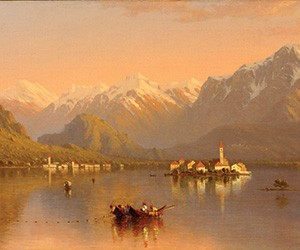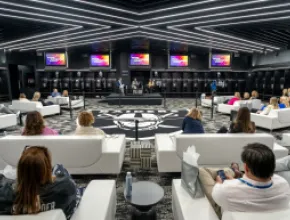From Niagara Reservation, the country’s first state park, to New York City, its first national capital in 1789, the state of New York is filled with a history as diverse as its landscape.
Throughout the state, history buffs will find an array of sites encompassing everything from its sports history to its political past. Following are eight great ways groups can step back in time in New York.
New-York Historical Society, New York
Founded in 1804, the New-York Historical Society’s museum brims with more than 1.6 million works. Highlights include vast collections of Hudson River School paintings and American portraits.
In addition, its Patricia D. Klingenstein Library is one of the oldest in the country. Groups can host events amid its 50-foot ceilings and stained-glass windows.
“We underwent a major renovation in 2011, so we’re still new and look fantastic,” says Laura Washington, vice president of communications for the New York Historical Society.
New spaces include the Dimenna Children’s History Museum and a 420-seat auditorium.
“We can use multiple spaces for cocktail receptions or seated dinners,” says Alex Maresca, director of special events. “We can also close off some galleries during the daytime.”
Some of the museum’s myriad group venues include Dexter Hall, featuring American art through the centuries, and the Henry Luce III Center, with more than 60,000 objects, including George Washington’s camp bed from Valley Forge.
New York State Museum, Albany
Albany’s New York State Museum, founded in 1836, is the country’s oldest and largest state museum, occupying the first four floors of the 10-story Cultural Education Center.
The museum includes everything from Native American history in the region to the original set from Sesame Street. It also houses the largest 9/11 permanent exhibition.
The biggest event space is the Fourth Floor Terrace, which overlooks Empire State Plaza, showcasing Albany’s architecture. Also on the fourth floor is a full-size carousel made between 1912 and 1916.
Groups can use the wilderness-themed Adirondack Hall for functions, according to Albert Gnidica, facility use coordinator for the museum.
There are also two theaters on property. PageBreak
Gold Coast Mansions, Long Island
With a little help from The Great Gatsby, Long Island is seeing a renewed interest in its famed Gold Coast Mansions. A handful of the remaining early 20th century estates are open to the public, some as hotels, others as museums, and some as historic grounds.
“We’ve had a lot of press with The Great Gatsby movie,” says Nancy Melius, founder of the Gold Coast Mansions Historic Long Island New York alliance.
The alliance helps market six of the mansions, including Oheka Castle Hotel & Estate, Old Westbury Gardens, Mill Neck Manor, Eagle’s Nest, as well as Vanderbilt Museum, Planting Fields-Coe Hall and the NYIT de Seversky Mansion, each of which has its own options for groups.
Oheka Castle, built in 1919 and currently a 32-room hotel, event space and restaurant, welcomes groups and can offer docent-led tours.
“When we took over the estate in 1984, it was in a state of disrepair,” says Melius, who is also director of marketing and design for Oheka. “We’ve retained the 1920s style.”
Options at other mansions include use of the planetarium, rose garden and courtyards at The Vanderbilt Museum and tours of the Coe Hall mansion, located at the Planting Fields Arboretum State Historic Park, which can be used for functions.
National Baseball Hall of Fame and Museum, Cooperstown
Gearing up for its 75th anniversary in 2014, the National Baseball Hall of Fame and Museum in Cooperstown spotlights more than 38,000 artifacts.
Exhibits include the Cooperstown Room, which examines the history of the Hall of Fame and the Hall of Fame Plaque Gallery, showcasing 300 Hall of Famers. The gallery is the main area for group functions.
“The gallery is an off-season facility,” says June Dolhun, sales manager for the museum, noting that Labor Day to Memorial Day weekends are ideal for groups as it closes at 5 p.m.
During summer the gallery closes at 9 p.m., but groups can still use the hall for after-hours events, such as dessert receptions.
Groups can rent the entire museum after hours for a private viewing. They can also organize special programs with the help of the Otesaga Resort Hotel in Cooperstown, such as Hall of Fame speakers for functions. PageBreak
Old Fort Niagara, Youngstown
Located where the mouth of the Niagara River meets Lake Ontario, the 22-acre Old Fort Niagara in Youngstown is home to the oldest original buildings on the Great Lakes.
Groups can use the oldest building at the fort, French Castle, built in 1726, for small receptions and dinners, or the 1920s-era Fort Niagara Officer’s Club just outside the walls of the fort.
Space for groups is relatively unlimited, considering the size of the grounds and the ability to set up tents outside.
“Groups can come for dinner and then can do lantern tours of the fort at night with ghost stories,” says Bob Emerson, executive director of Old Fort Niagara.
Another option is to host a dinner followed by a half-dozen soldiers in uniform firing cannons or muskets.
Theodore Roosevelt Inaugural Site, Buffalo
Originally built in 1840, the Theodore Roosevelt Inaugural National Historic Site was used for the inauguration of Theodore Roosevelt in 1901.
In 2009, the site received an upgrade, making it even more attractive for history fans.
“We have a guided tour unlike any other museum experience,” says Janice Kuzan, assistant director of the Theodore Roosevelt Inaugural Site. “Now there is a lot of interactive multimedia installations that immerse you in the time Roosevelt lived in the house.”
Part of the upgrade was the recreation of the Wilcox Carriage House on its original foundation. The second floor of the Carriage House is open to groups.
“Our staff can also set up a number of historical programs, and can bring in a historian,” Kuzan says. PageBreak
Lake Placid Olympic Center
Nothing will compare in sports history to the 1980 Miracle on Ice, when the U.S. men’s hockey team defeated the Soviet Union on its way to winning the gold medal.
Held at the Lake Placid Olympic Center, built in 1932, the historic win can be integrated into group functions in a number of ways.
Groups can set up dinners for up to 400 on the ice at the Herb Brooks Arena, replete with an ice show, according to Jackie Kelly, conference center coordinator for the New York State Olympic Regional Development Authority (ORDA).
“We can reach out to members of the 1980 team, some of whom have become motivational speakers, and present at an evening function,” Kelly says.
Groups can organize team-building activities on the ice such as curling competitions and slapshot competitions.
The James B. Sheffield Olympic Skating Rink is available for opening ceremonies, including an Olympic torch, and the Lake Placid Olympic Museum offers space for small receptions.
Bethel Center for the Arts, Bethel
Woodstock aficionados will likely be making a pilgrimage next year to the Bethel Center for the Arts, as it prepares a full lineup of programs in honor of the 45th anniversary of the 1969 Woodstock Festival.
The cultural center comprises a 15,000-seat outdoor amphitheater, a 440-seat indoor performance space and a museum situated on approximately 800 acres of grounds located on the original festival site.
For a historic perspective, The Museum at Bethel Woods offers an interactive multimedia experience to tell the story of the ’60s and Woodstock.
Groups can use the Events Gallery at the museum for sit-down dinners or receptions. More casual outdoor sheds are also available for smaller functions.
Marlene Goldman is a former Meetings Focus editor and a native New Yorker.







